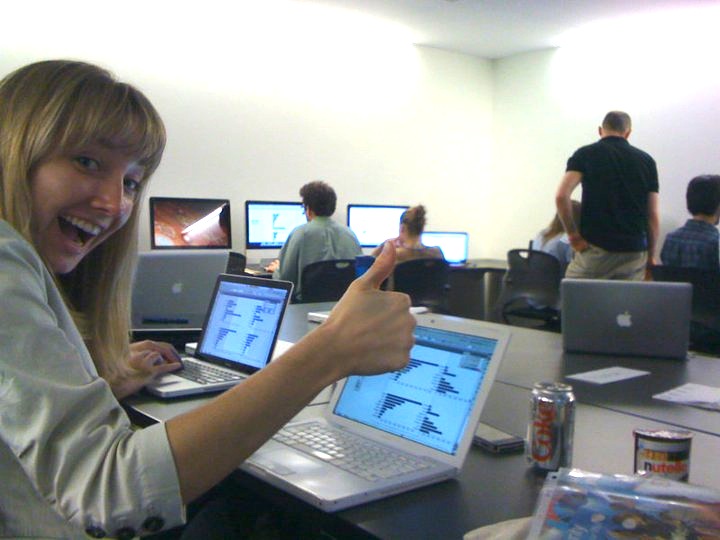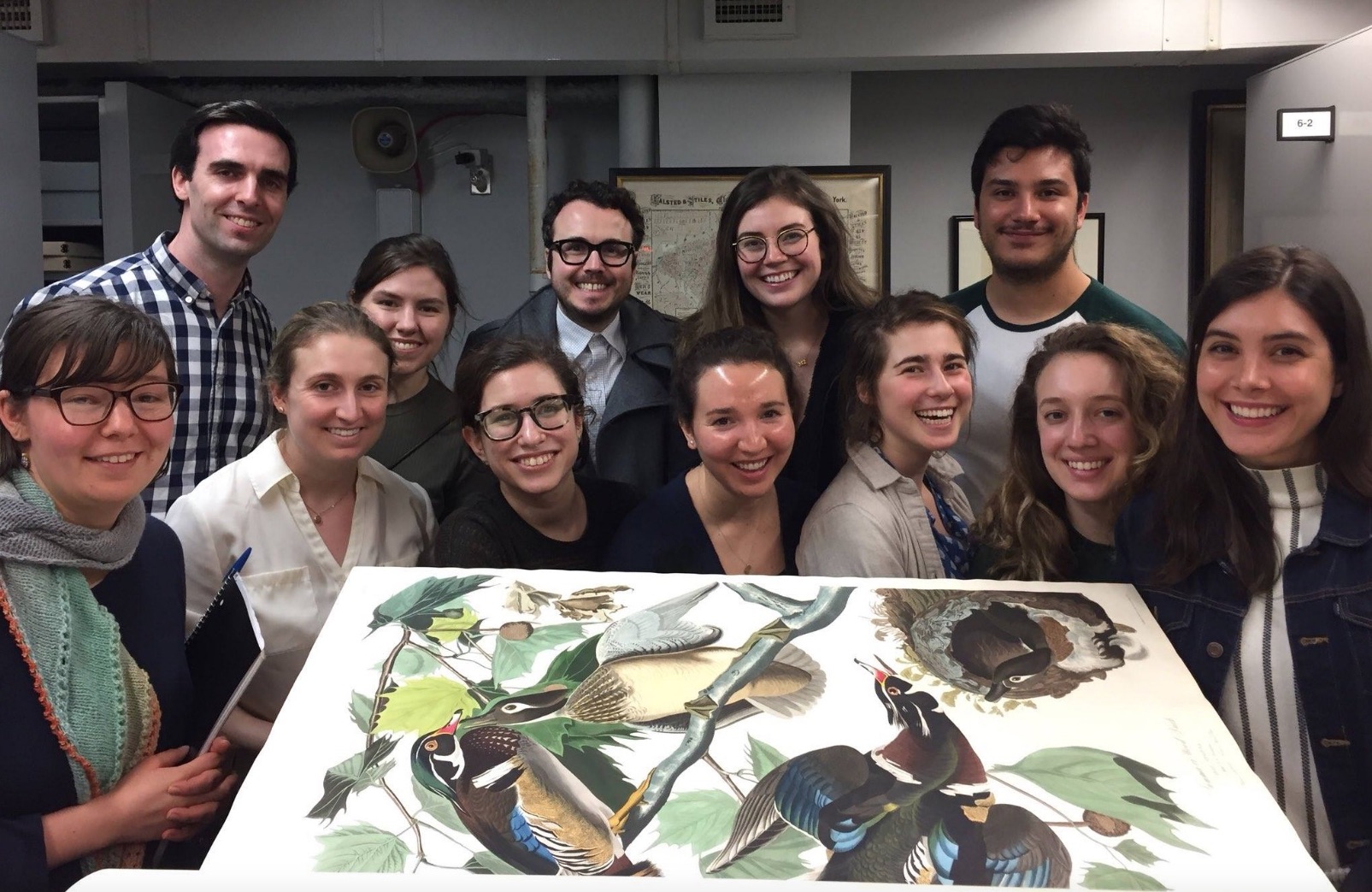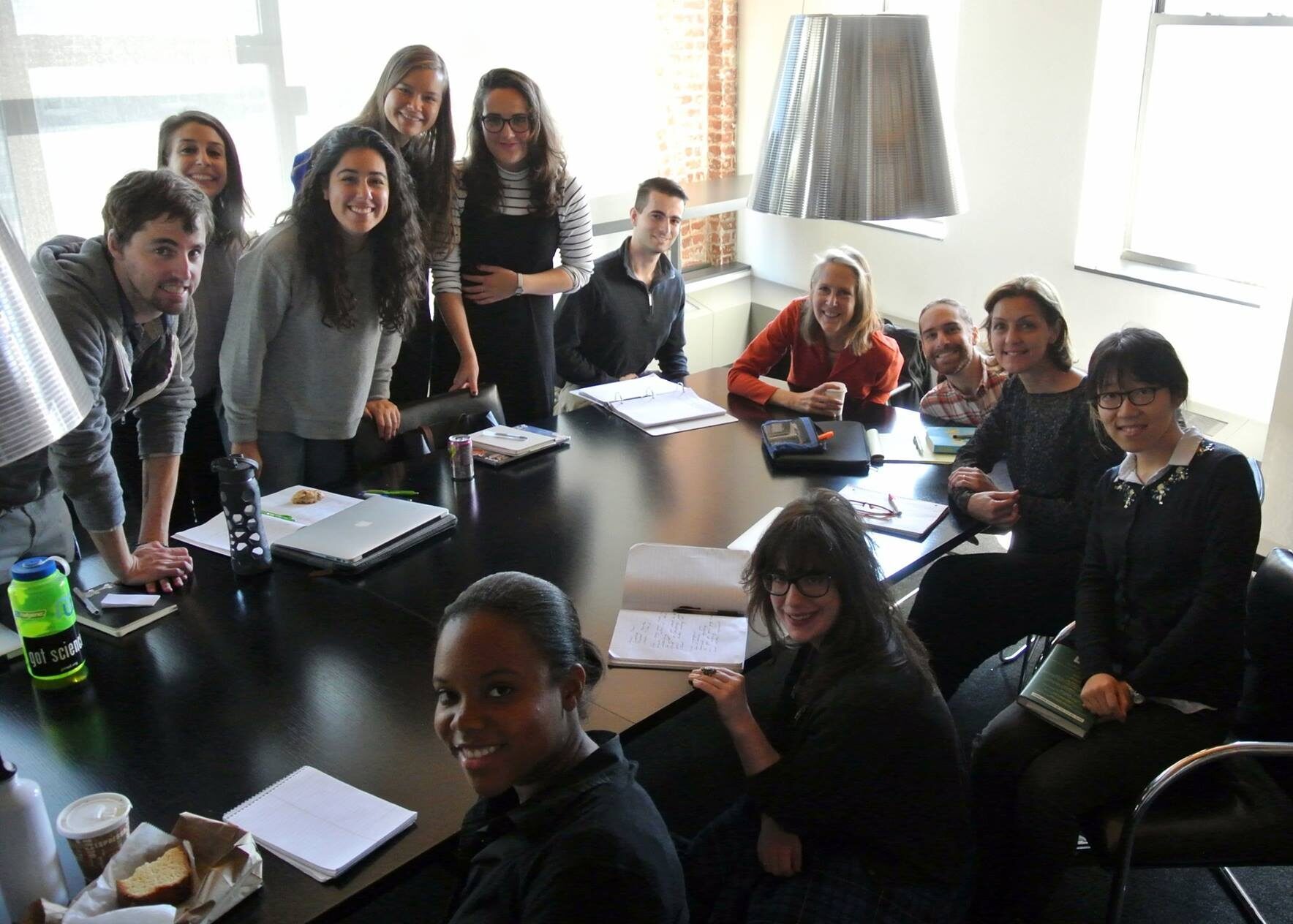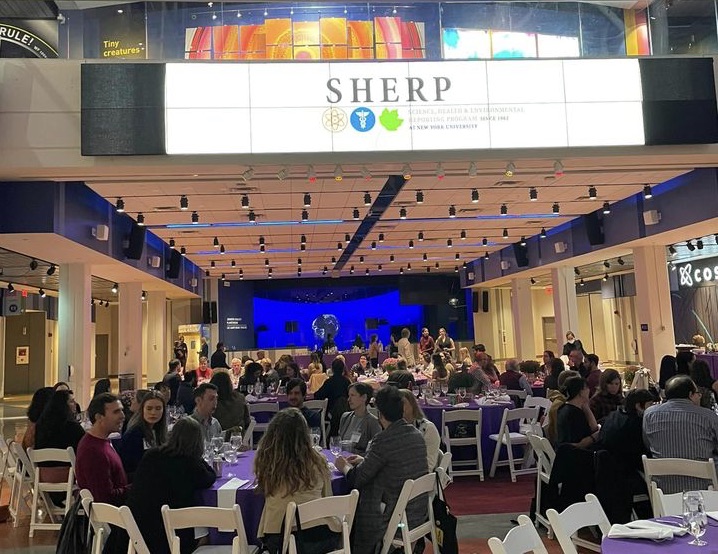Curriculum & Speakers
Our classwork is built around real-world reporting and extensive interactions with leading practitioners in journalism and science.
Quick links: first semester, second semester, summer semester, third semester, recent guest speakers, faculty,
The SHERP sequence consists of 11 classes (including one elective) over 16 months, for a total of 38 credits. Beyond the elective class in the final semester, it is also possible to further customize the curriculum by substituting other courses (including non-Journalism classes) for required SHERP classes, with the permission of the program director. Graduates receive a Master of Arts in Journalism with a concentration in Science, Health and Environmental Reporting.
In addition to regular classes, we teach multimedia storytelling via two intensive, eight-week workshops (audio in the first semester and video in the second) plus an additional four weeks of data visualization instruction in the spring. We want our graduates to be “platform agnostic” storytellers; the comprehensive skill sets they develop at SHERP give them the freedom to choose the best way to tell every story — and to compile diverse portfolios that show prospective employers exactly what they can do. You can see some of the students’ audio and video work on Scienceline.

Building data graphics in class.
SHERP students learn many other skills, too, including data mining via Python and R, fact-checking, and survival skills for freelancers (about one-third of our graduates decide to freelance instead of taking staff jobs).
The program’s award-winning student-run webzine, Scienceline, is fully integrated into coursework. SHERP students assign, report and edit stories, blogs, videos, audio podcasts and data visualizations, many of which begin as class assignments.
NEWS! Thanks to recent funding, SHERP is now also providing major support for student reporting trips all over the world, culminating in great published clips from Armenia, Hawai’i, Arizona, Italy, Puerto Rico, Italy (again!), California, Panama, Maine, and Tanzania, among other places (follow the links and take a look!).
SHERP also funds student attendance at the annual conferences of the National Association of Science Writers, the Society of Environmental Journalists, and the Association of Health Care Journalists. (SHERP’s faculty includes former presidents of all three groups.) There are also fellowship opportunities for students to attend other conferences, including the Society for Neuroscience, the American Geophysical Union, and the American Association for the Advancement of Science.

Viewing a first edition of John James Audubon’s Birds of America on a behind-the-scenes field trip to the American Museum of Natural History.
In New York, SHERP regularly organizes seminar field trips to the New York Times, the American Museum of Natural History, Jamaica Bay National Wildlife Refuge, the New York Aquarium, Brookhaven National Laboratory and elsewhere. Wherever we go, we go behind the scenes and meet with scientists and journalists.
In addition to bringing in dozens of prominent guest speakers every semester, SHERP regularly hosts evening discussion events on subjects ranging from developing book ideas to writing about parenthood. Our newest series, the Art of Freelancing, features world-class freelance science journalists breaking down various aspects of the craft. Before that, we featured the recently concluded Kavli Conversations on Science Communication at NYU, interactive moderated conversations between leading science journalists and eminent scientists. The “Kavlis” have attracted more than 80,000 views online and in person — take a look for yourself! You can also watch videos of our earlier “Inside Out” evening discussion series. SHERP students also interact with Ph.D. students, post-docs, medical students and science faculty at NYU who sign up for Science Communication Workshops, which are four-week short courses that introduce scientists to the basics of communicating research to lay audiences.

Meeting with Visiting Science Journalist Mary Roach.
We also bring in eminent science journalists to work with our students and alumni via SHERP’s Visiting Science Journalist program. Best-selling science writer Mary Roach was our inaugural Visiting Science Journalist, later joined by Pulitzer Prize-winning New Yorker staff writer Kathryn Schulz, author David Quammen, Scientific American editor-in-chief Laura Helmuth, and Open Notebook co-founder and editor-in-chief Siri Carpenter. Our students also interact with “visiting scholars” who are leading figures in the world of science journalism. These SHERP visiting scholars have included Carl Zimmer, Maria Konnikova, Melinda Wenner Moyer, Mariette DiChristina, David Corcoran, Corey Powell, Amy Harmon, Virginia Hughes, Robin Lloyd and Anna Rothschild.
Another curricular opportunity for SHERP students is the Physics Journalism Fellowship, funded by the National Science Foundation via NYU Assistant Professor of Physics Joshua Ruderman. Fellows pursue in-depth reporting projects at the frontiers of physics. The first recipient, Ryan Mandelbaum, visited CERN (the European Organization for Nuclear Research) in Geneva and published this story in Gizmodo based on his fellowship experience. Mark Kaufman went to Los Alamos National Laboratory in New Mexico and wrote about Martian exploration for Mashable. Charlie Wood visited the Atacama Large Millimeter/Sub-millimeter Array (ALMA) in Chile and wrote about the birth of planets for Popular Science. Dana Najjar traveled to Louisiana to see LIGO (the Laser Interferometer Gravitational-Wave Observatory) and wrote about the intricate science of measuring gravitational waves for LiveScience. Daniel Leonard went to Puerto Rico to cover the ill-fated Arecibo telescope for Scientific American. Most recently, Gwendolyn Rak visited the Vatican Observatory and wrote about ancient asteroids for Mercury magazine.

Celebrating our 40th anniversary at the Liberty Science Center.
We host special events, too. In 2022, more than 200 alumni, students and friends attended SHERP’s 40th birthday gala at the Liberty Science Center in Jersey City. Ten years earlier, 170 gathered to celebrate our 30th anniversary, which included a panel discussion (watch the video!) with best-selling authors Rebecca Skloot and Mary Roach and Radiolab creator Jad Abumrad. And in 2007, we celebrated our 25th anniversary with a full day of events, including a symposium on artificial life featuring famed geneticist J. Craig Venter.
First Semester (Fall) Classes
Writing and Reporting Workshop I (Prof. Robin Marantz Henig, four credits) introduces students to the tools of the trade, while helping them report, write and, most importantly, think like journalists. Students learn the ingredients of a great news story, along with basic reporting techniques such as how to find story leads, track down information sources, and nail an interview. They also learn the principles of how to write with clarity, accuracy and style, and how to make the most of the editing process. In this class, SHERP students are also introduced to the burgeoning world of digital journalism, including multimedia production. They put their new skills into practice with varied assignments. Pitching stories to professional sites with an eye to publication is an integral part of this class. In consultation with the NYU Office of Global Services and SHERP’s international student advisor, international students in this practicum class may use the Curricular Practical Training option to publish their work professionally.
Current Topics in Science, Health and Environmental Journalism (Prof. Dan Fagin, four credits) introduces students to the world of science journalism by looking at scientific topics that are at the cutting-edge of research and have profound implications for the way we live. In other words, they are the raw material for great journalism. As students immerse themselves in some challenging areas of current science, they read the work of highly accomplished researchers and journalists and also hear from them directly in class. The goal throughout is to understand and adopt the practices that the best science journalists use when they cover controversial science. Students learn how journalists interact with scientists, conduct research, organize information and write stories. Just as importantly, students sharpen their analytical skills by writing almost every week for Scienceline. Covering an assigned beat, students follow the peer-reviewed journals and other sources to stay on top of the news as it happens.
Medical Reporting (Prof. Ivan Oransky, M.D., four credits) provides an in-depth look at many of the most important contemporary topics in the always dynamic field of medical journalism, including the biology of cancer, environment-related illness, epidemiology, and the precepts of sound medical research and peer review. Students write several short pieces on journal reports, medical conferences and community health lectures, and one longer, feature-length piece on a health topic of their choice. Medical researchers and prominent journalists are frequent guest speakers.
Second Semester (Spring) Classes
Writing and Reporting Workshop II (Prof. Lindsey Gellman, four credits) is an introduction to long-form science journalism. Drawing on the narrative techniques of great fiction, students produce news features, books (proposals and outlines), reported essays, audio reports and explanatory pieces. In addition to these major assignments, there are extensive in-class writing and reading exercises, including character sketches, op-eds and close textual analysis. Pitching stories to professional sites with an eye to publication is an integral part of this class. In consultation with the NYU Office of Global Services and SHERP’s international student advisor, international students in this practicum class may use the Curricular Practical Training option to publish their work professionally.
Environmental Reporting (Prof. Dan Fagin, four credits) has three major components. Students focus on writing — and rewriting! — insightful stories about environment-related topics that are often emotionally charged and highly politicized. They also take deep dives into a series of crucial but often misunderstood topics such as risk assessment, epidemiology, environmental law, climate science, framing and the use of databases and other investigative tools. And finally, they read and discuss the work of exemplary environmental writers and thinkers, from Henry David Thoreau and Aldo Leopold to John McPhee and Bill McKibben. As they explore each of these three components, students practice many forms environmental journalism, including news stories, features, topical profiles, blog posts, persuasive columns and descriptive essays. They also critique newly published environmental journalism every week.
Investigative Science Journalism (Prof. Charles Seife, four credits) gives students the tools they will need to see through lies and shed light on facts that certain people would rather keep hidden. By the end of the semester, they will be able to sniff out deception and find the facts to uncover it; they’ll also be relentless — unwilling to let go once they seek their teeth into a juicy story. SHERP students will get the mathematical knowledge, investigative reporting techniques, and computer skills that will help them cut through hype and obfuscation, and it will do so by having them perform first-rate investigations on important scientific or medical topics. After completing this course, students will be formidable — and dangerous — reporters.
Summer Session Classes
Journalistic Judgment (Prof. Robin Marantz Henig, four credits) is SHERP’s press ethics class. It emphasizes the special dilemmas and unique ethical decisions that come with covering science, health and environmental news. The First Amendment, libel, censorship (including self-censorship), transparency and ethical decision-making are key topics in this class.
Fieldwork in Journalism (Prof. Rachel Nuwer, one credit) is the first of two required internships. (A few students also intern in the spring.) Preparatory work for the internships actually begins during the first semester of SHERP, when the program’s internship coordinators work with students to prepare resumes and cover letters and assist them in identifying opportunities that fit their interests and aspirations. A Meet the Editors and Producers event, typically attended by more than 30 supervising editors who work with SHERP, is part of this process. International students may use the Curricular Practical Training option for their internships.
Third Semester (Fall) Classes
Science Writing (Prof. John Rennie, four credits) is an advanced class that draws on all the skills students have practiced and polished during the previous year. The goal is to give a realistic preview of life as a working science journalist, from finding a story idea to pitching it to surviving the editing process to making sure the final product is accurate, clear and compelling. The class looks at science journalism from the editor’s point of view, and also emphasizes the process of popularizing complex scientific and technical information for the mass media. Students produce at least one feature-length story, as well as several shorter pieces. The goal, as ever, is for students to write stories they can pitch to professional publications. In consultation with the NYU Office of Global Services and SHERP’s international student advisor, international students in this practicum class may use the Curricular Practical Training option to publish their work professionally.
Elective (four credits each). In their final semester, SHERP students can explore areas of special interest by taking a course offered elsewhere in the Carter Institute (or, by special permission, elsewhere in the university). Possibilities at the institute include graduate courses in advanced television and radio production, data journalism, investigative reporting, business journalism, essay writing, journalism and epidemics, criticism, ethnography and journalism, history of media, literary journalism, cultural reporting, hyperlocal coverage and food journalism, among others.
Fieldwork in Journalism (Prof. Rachel Nuwer, one credit) is the second of two required internships. During this final semester, the focus is on transitioning from internships to full-time work on staff or as a freelancer. Every year, several SHERP students land full-time jobs at places where they have interned. International students may continue to use the Curricular Practical Training option for their internships..
Recent Guest Speakers
A partial list of guest speakers in SHERP classes since 2023:
- Brianna Abbott (SHERP 36), health reporter, Wall Street Journal
- Julie Appleby, reporter, Kaiser Health News
- Amanda Barrett, vice president of news, standards, and inclusion, Associated Press
- Jennifer Bogo, vice president for content, Popular Science
- Kate Bolger, partner and 1st Amendment lawyer, Davis Wright Tremaine
- Brooke Borel, author and freelancer
- Sophie Bushwick, senior news editor, New Scientist
- Jeanna Bryner (SHERP 21), managing editor, Scientific American
- Justine Calma, senior science reporter, The Verge
- Alicia Chang, science writer, Associated Press
- Angela Chen, senior editor, Vox,
- Casey Crownhart (SHERP 39), senior climate reporter, Technology Review
- Phil Corbett, standards editor, New York Times
- Jeff Delviscio, head of video, Scientific American
- Arielle Duhaime-Ross (SHERP 31), correspondent and podcast host, Vice News/li>
- Katherine Eban, author, investigative reporter
- Juliet Eilperin, deputy climate and environmental editor, Washington Post/li>
- Rose Eveleth (SHERP 29), freelance writer and producer
- Jon Fahey, global health and science editor, Associated Press
- David Folkenflik, media reporter, NPR
- Matt Giles, research director, Wired
- Cynthia Graber, co-host, Gastropod
- David Grimm, online news editor, Science
- Prachi Gupta, freelance writer and author
- Tara Haelle, freelance writer
- Mary Harris, audio producer and host, Slate
- Michelle Harris, fact-checker, New York Times
- Amy Harmon, special projects correspondent, New York Times
- Chelsea Harvey (SHERP 32), reporter, Climatewire
- Samantha Henig, editorial director for audio, New York Times
- Scott Hensley, pharmaceutical industry reporter, The Wall Street Journal
- Amanda Hess, culture reporter, New York Times
- Jackson Howard, senior editor, Farrar, Straus and Giroux/li>
- Virginia Hughes, deputy science editor, New York Times
- Jeremy Hsu, (SHERP 25), technology reporter, New Scientist
- Sabrina Imbler, staff writer, Defector, and author
- Ferris Jabr (SHERP 28), author and contract writer, New York Times Magazine
- Miriam Kramer (SHERP 30), space beat writer, Axios
- Betsy Ladyzhets, freelance journalist and creator, Covid-19 Data Dispatch
- Stephanie Lee, reporter, Chronicle of Higher Education
- Sharon Lerner, investigative environmental reporter, ProPublica.
- Vernon Loeb, executive editor, Inside Climate News
- Abrahm Lustgarten, energy and environmental reporter, ProPublica
- Douglas Main (SHERP 29), senior writer/editor, National Geographic
- Claire Maldarelli (SHERP 32), senior science editor, Inverse
- Apoorva Mandavilli, (SHERP 17), public health reporter, New York Times
- Adam Marcus, editorial director for primary care, Medscape
- Emma Marris., author and freelancer
- Teresa Mathew, fact-checker, The New Yorker
- Allison McCann (SHERP 30), visual journalist, New York Times
- Angely Mercado, staff writer, Gizmodo, and freelance fact-checker
- Nina Mesfin, fact-checker, The New Yorker
- Robinson Meyer, executive editor, Heatmap News
- Claudia Milne, senior vice president of standards and practices, CBS News
- Michael Moyer, deputy editor, Quanta
- Eric Nelson, Executive Editor, HarperCollins
- Lily Hay Newman (SHERP 31), security reporter, Wired
- Amy Nordrum (SHERP 32), executive editor for operations, MIT Technology Review
- Rachel Nuwer (SHERP 29), freelance writer and author
- Charles Ornstein, managing editor for local news, ProPublica
- Michael Oppenheimer, professor of geoscience and international affairs, Princeton University
- Shannon Palus, science editor, Slate
- Charles Piller, reporter, Science
- Corey Powell, editor, Open Mind, and editor at large, Discover
- Lizzie Presser, social policy reporter, ProPublica/li>
- Evan Ratliff, co-founder of The Atavist, author
- Rachel Riederer, reporter, The New Yorker
- Don Riepe, Jamaica Bay Guardian
- Malcolm Ritter, science writer, Associated Press
- Mathew Rodriguez, freelance writer
- Max Rivlin-Nadler, co-founder of and editor, Hell Gate
- Michael Roston, staff editor for science, New York Times
- Naveena Sadasivam (SHERP 31), senior staff writer, Grist
- Catherine Saint Louis, executive editor of podcasts, Sony Music Entertainment
- Zoe Schlanger, staff writer, The Atlantic
- Jennifer Schmidt, managing editor, EOS
- Somini Sengupta, international climate reporter, New York Times
- Jennifer Senior, author and writer, Atlantic
- Hannah Seo (SHERP 38), freelance writer
- Virginia Sole-Smith, writer and podcaster
- Lisa Song, environmental reporter, ProPublica
- Victoria St. Martin, deputy national editor, Capital B News
- Maxwell Strachan, deputy health editor, New York Times
- Hillery Stone, freelance writer
- Margaret Sullivan, director, Newmark Center for Journalism Ethics and Security
- Maxwell Tani, media editor, Semafor
- Andrea Thompson, (SHERP 24) sustainability editor, Scientific American
- Esther Wang, co-founder and editor, Hell Gate
- David Wallace-Wells, author and columnist, New York Times
- Molly Webster (SHERP 25), features producer and substitute host, RadioLab
- Susan Wessling, standards editor, New York Times
- Isobel Whitcomb (SHERP 37), freelance writer
- Amber Williams (SHERP 29), senior staff editor, New York Times
- Paige Williams, writer, The New Yorker
- Lauren Young (SHERP 33), associate editor for health and medicine, Scientific American
- Sarah Zhang, staff science writer, The Atlantic